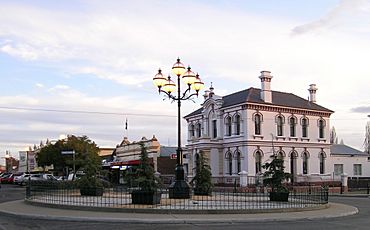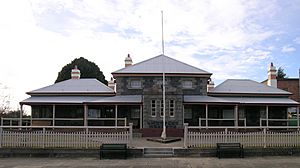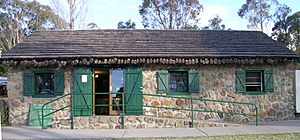Glen Innes, New South Wales facts for kids
Quick facts for kids Glen InnesNew South Wales |
|||||||||
|---|---|---|---|---|---|---|---|---|---|

Grey Street, Glen Innes
|
|||||||||
| Population | 6,219 (2021 census) | ||||||||
| Established | 1852 | ||||||||
| Postcode(s) | 2370 | ||||||||
| Elevation | 1,062 m (3,484 ft) | ||||||||
| Time zone | AEST (UTC+10) | ||||||||
| • Summer (DST) | AEDT (UTC+11) | ||||||||
| Location | |||||||||
| LGA(s) | Glen Innes Severn Shire Council | ||||||||
| County | Gough | ||||||||
| State electorate(s) | Northern Tablelands | ||||||||
| Federal Division(s) | New England | ||||||||
|
|||||||||
Glen Innes is a town located in the New England region of New South Wales, Australia. It sits on the Northern Tablelands. The town is the main centre for the Glen Innes Severn Shire Council. You can find it where the New England Highway and the Gwydir Highway meet. In 2021, about 6,219 people lived in Glen Innes.
Contents
History of Glen Innes
First People of Glen Innes
The original people of Glen Innes and the areas around it are the Ngarabal people. They called the township Gindaaydjin. This name means "plenty of big round stones on clear plains."
When European settlers arrived, it greatly changed the lives of the Ngarabal people. Many Ngarabal people still live in the Glen Innes area today. They continue to practice parts of their traditional culture and way of life.
Early European Settlement
Around 1838, Archibald Boyd was the first to claim land in the Glen Innes district. Two stockmen, known as "the Beardies" because of their long beards, helped Boyd set up his land claim. These Beardies later showed other settlers the best places to live. This area became known as the Land of the Beardies or Beardie Plains.
A new town was planned, and Furracabad Station was suggested as a good spot. However, Furracabad Station was sold during a tough economic time in the 1840s. It was owned by several people, including Major Archibald Clunes Innes. Finally, Archibald Mosman bought it. It is believed that Mosman named the town Glen Innes to honor Innes.
Growth of the Town
Glen Innes officially became a town in 1852. The first land lots were sold in 1854. A post office opened in August 1854, and a court was set up in 1858. By 1866, about 350 people lived there. The town had a telegraph station, a lands office, police barracks, a courthouse, a post office, and two hotels.
In the 1870s, a road was built to Grafton. This helped the town grow.
Mining Boom and Railway
Tin was found near Emmaville in 1872. This discovery made Glen Innes a busy mining hub in the late 1800s. By 1875, the population had grown to about 1,500 people. The town had a school, three churches, five hotels, two newspapers, and many shops and groups.
On August 19, 1884, the new Main North railway from Sydney opened. The railway and the growing mining industry brought new wealth to the town. This wealth is still seen in some of the beautiful old buildings.
Historic Buildings
The center of Glen Innes still has many of its old federation buildings. Owners have painted these buildings in their original colors. Many of these buildings are now protected as part of Australia's national heritage.
The town also has a railway station that was once part of the Main North Line. Today, the train line is closed, so the station is no longer used for trains. Its buildings have been given new purposes.
Heritage Sites
Glen Innes has several places listed for their historical importance:
- Bourke Street: Glen Innes Showground
- Grey Street: Glen Innes Post and Telegraph Office
- Main Northern railway: Glen Innes railway station
- Main Northern railway, 694.371 km: Yarraford Rail Bridge over Beardy River
People of Glen Innes
| Historical population | ||
|---|---|---|
| Year | Pop. | ±% |
| 1921 | 4,974 | — |
| 1933 | 5,352 | +7.6% |
| 1947 | 5,453 | +1.9% |
| 1954 | 5,842 | +7.1% |
| 1961 | 5,773 | −1.2% |
| 1966 | 5,756 | −0.3% |
| 1971 | 5,770 | +0.2% |
| 1976 | 5,953 | +3.2% |
| 1981 | 6,052 | +1.7% |
| 1986 | 5,971 | −1.3% |
| 1991 | 6,140 | +2.8% |
| 1996 | 6,101 | −0.6% |
| 2001 | 5,722 | −6.2% |
| 2006 | 5,944 | +3.9% |
| 2011 | 6,135 | +3.2% |
| 2016 | 6,155 | +0.3% |
| 2021 | 6,219 | +1.0% |
| Source: Australian Bureau of Statistics data. | ||
The 2021 census showed that 6,219 people lived in Glen Innes.
- About 6.8% of the people were Aboriginal and Torres Strait Islander.
- Most people (82.1%) were born in Australia. The next largest group (2.0%) was born in England.
- About 88.0% of people spoke only English at home.
- The most common religions were Anglican (29.0%), Catholic (21.0%), and No Religion (19.5%).
Industries and Economy
The Glen Innes area has always been known for producing wool, sheep, and beef cattle. Sapphires are still mined in the creek valleys west of town. While tin mining is not as big as it used to be, people are still looking for minerals.
The town holds regular sales for livestock at the local sale-yards. Glen Innes also has many businesses that provide services to the community. These include a photo processing place, a company that exports waste balers, a large cattle feedlot, and transport depots.
Sawmilling used to be a major industry. Now, it is mainly done by the local minimum-security prison. Many State Forests have become National Parks. This has made tourism an important job provider in the area.
Climate and Weather
Glen Innes is about 1,062 meters (3,484 feet) above sea level. It gets an average of 901.8 millimeters (35.5 inches) of rain each year. The climate is a temperate oceanic climate. This means it has mild to warm summers and cold, windy winters.
The area often has frosts and sometimes snow, though the snow does not always stay on the ground. Glen Innes records some of Australia's coldest temperatures outside of the Snowy Mountains and Tasmania.
The highest temperature ever recorded in Glen Innes was 37.3°C (99.1°F) on December 22, 2019. The coldest was -12.8°C (9.0°F) on July 8, 2002. On July 19, 2019, the town recorded -12.3°C (9.9°F), making it the coldest place in Australia that day. Rain is heaviest in late spring. This is because the surrounding mountains cause frequent, heavy storms.
| Climate data for Glen Innes Airport AWS (1996–2022); 1,044 m AMSL; 29.68° S, 151.69° E | |||||||||||||
|---|---|---|---|---|---|---|---|---|---|---|---|---|---|
| Month | Jan | Feb | Mar | Apr | May | Jun | Jul | Aug | Sep | Oct | Nov | Dec | Year |
| Record high °C (°F) | 37.2 (99.0) |
36.9 (98.4) |
32.7 (90.9) |
28.7 (83.7) |
23.9 (75.0) |
22.1 (71.8) |
20.4 (68.7) |
27.7 (81.9) |
29.0 (84.2) |
32.0 (89.6) |
35.2 (95.4) |
37.3 (99.1) |
37.3 (99.1) |
| Mean daily maximum °C (°F) | 26.6 (79.9) |
25.8 (78.4) |
24.0 (75.2) |
20.7 (69.3) |
16.9 (62.4) |
13.8 (56.8) |
13.4 (56.1) |
15.0 (59.0) |
18.4 (65.1) |
21.2 (70.2) |
23.2 (73.8) |
25.3 (77.5) |
20.4 (68.7) |
| Mean daily minimum °C (°F) | 13.0 (55.4) |
12.9 (55.2) |
11.0 (51.8) |
6.7 (44.1) |
2.2 (36.0) |
0.2 (32.4) |
−1.0 (30.2) |
−0.9 (30.4) |
2.5 (36.5) |
5.8 (42.4) |
9.0 (48.2) |
11.5 (52.7) |
6.1 (43.0) |
| Record low °C (°F) | 2.3 (36.1) |
2.8 (37.0) |
−3.4 (25.9) |
−6.0 (21.2) |
−9.8 (14.4) |
−11.6 (11.1) |
−12.8 (9.0) |
−12.8 (9.0) |
−8.0 (17.6) |
−5.2 (22.6) |
−1.1 (30.0) |
−1.7 (28.9) |
−12.8 (9.0) |
| Average rainfall mm (inches) | 99.7 (3.93) |
87.7 (3.45) |
89.8 (3.54) |
48.4 (1.91) |
47.7 (1.88) |
54.0 (2.13) |
53.9 (2.12) |
50.4 (1.98) |
58.0 (2.28) |
82.4 (3.24) |
118.1 (4.65) |
111.7 (4.40) |
901.8 (35.51) |
| Average rainy days (≥ 1.0 mm) | 8.0 | 7.1 | 6.7 | 4.0 | 4.6 | 5.6 | 5.8 | 5.1 | 5.5 | 7.2 | 8.6 | 9.4 | 77.6 |
| Average afternoon relative humidity (%) | 52 | 56 | 52 | 50 | 51 | 56 | 52 | 46 | 45 | 46 | 54 | 51 | 51 |
| Source: Bureau of Meteorology | |||||||||||||
Culture and Things to Do
There are many fun things to see and do in the Glen Innes area.
- Visit the Land of the Beardies History Museum. It has a large collection of local history.
- Enjoy the town parks.
- Go fishing or fossicking for gems.
- Explore the Gibraltar Range National Park and its many waterfalls.
- See the Australian Standing Stones, which are large monoliths.
- Discover the World Heritage listed Washpool National Park.
Churches and Faith
Glen Innes has several Christian churches. These include the Cameron Memorial Uniting Church and St Andrews Presbyterian Church, which show the town's Scottish roots. There are also the Holy Trinity Anglican and St Patrick's Catholic Churches, along with Baptist, Assembly of God, and Seventh Day Adventist congregations.
Festivals and Events
Each year, Glen Innes hosts several exciting events:
- Minerama: A festival for gems and fossicking.
- Australian Celtic Festival: A celebration of Celtic culture.
- Land of the Beardies Festival: A local community festival.
- Pastoral and Agricultural Show: A show featuring local farming and animals.
- Horse racing, including the Glen Innes Cup.
Arts and Entertainment
The Glen Innes Arts Council puts on its own plays and shows throughout the year. They also host traveling performances and movie screenings. It is the longest-running arts council in Australia. Their venue, The Chapel Theatre, has a modern 3D Digital Cinema system. You can find more information on their website: http://www.gleninnesartscouncil.com
The town also has a lively arts and crafts community. The Glen Innes Art Gallery holds regular exhibitions of local and visiting artists.
Sports in Glen Innes
The most popular sport in Glen Innes is rugby league. The town's team, the Glen Innes Magpies, used to play in the Group 19 Rugby League A-Grade competition. However, in 2022, they had to stop playing due to a lack of players.
Glen Innes has annual competitions and teams in many other sports, including:
- Golf
- Rugby Union
- Soccer
- Lawn Bowls
- Tennis
- Netball
- Basketball
- Cricket
- Squash
- Touch Football
- Tent Pegging
- Campdrafting
- Shooting
- Sheepdog trials
- Roller Skating
- Roller Hockey
Local Media
Local news for Glen Innes is provided by the Glen Innes News. It publishes both online and in print.
The district also has a community radio station, 2CBD FM. It broadcasts on 105.9FM in Glen Innes and 91.1FM in Deepwater.
Famous People from Glen Innes
Glen Innes is the birthplace of several notable people:
- D'Arcy Niland: A well-known writer.
- Edward McTiernan: A judge of the High Court.
- Colin Madigan and Nancy Allen: Famous architects.
Other famous people who used to live in Glen Innes include:
- Bishop Thomas Absolem McCabe: The first bishop of Wollongong.
- Margaret Fulton: Australia's first famous real-food cookbook author.
- Garry McDonald: An actor known for "Norman Gunston" and "Mother and Son."
The district has also produced several athletes who have represented Australia:
- Two Olympians: Debbie Wells and David Cooper.
- Rugby League players: Reg O'Keefe and John Ferguson.
- Pistol shooters: Bruce Favell and Robert Landers.
- Masters athletics world champion: Neville McIntyre.
- Tentpegging champion: Andrew McIntyre.
Several highly decorated military service members also have family in the district. These include Peter Turnbull and Charles Curnow Scherf. Another important soldier from Glen Innes was Edward (Ted) Kinsella. He served in Greece, Gallipoli, and France.
Glen Innes and Scotland
Glen Innes has strong ties to Scotland. Archibald Clunes Innes, who was from Thrumster, Caithness in Scotland, arrived in Australia in 1822. He was a captain in the Third Regiment. He owned several properties in New England, including Glen Innes Station.
The town has some street signs in Scottish Gaelic, even though no one in the town speaks the language. There is also a "Crofter"'s cottage, which is a type of traditional Scottish farm building.
The Australian Standing Stones in Glen Innes are inspired by ancient stone circles in Scotland. These include the Ring of Brodgar in Orkney or Calanais in Lewis.
Pitlochry in Scotland is a twin town to Glen Innes.
Other nearby towns also have Scottish names, such as Armidale, Ben Lomond, and Glencoe. The name of nearby Inverell also comes from Scottish Gaelic. It means "meeting place of the swans," referring to the black swans once seen on the Macintyre River.
Twin Towns
Glen Innes has twin town relationships with:
Wind Farm
Glen Innes is home to a large wind farm called White Rock Wind Farm. The New South Wales Government approved this project, which is located 23 kilometers (14 miles) west of the town.
The wind farm has 70 turbines, each standing 150 meters (492 feet) tall. A second stage, with another 49 turbines and a Solar Farm, has also been approved by the NSW Government.
See also
 In Spanish: Glen Innes para niños
In Spanish: Glen Innes para niños






